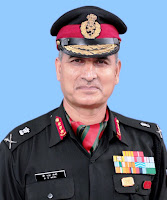(Author: Dr Balwant Singh Negi)
The book of the Moment!
For over two months soldiers of the Chinese Army - the People's Liberation Army (PLA) of China - had been wrestling with the Indian Army soldiers staking their claim on the Bhutanese territory at Doklam. Thankfully, sanity prevailed and the duel has not flared up into a war between the two Asian Nuclear powers, and the PLA has reportedly withdrawn from the Bhutanese territory. Belligerent outbursts of the Chinese media are also somewhat subdued now.
 |
| Hardcover, Fully illustrated, indexed, |
The book is available with a discount offer on sale at the following portals:-
www.turningpointpublishers.com
www.flipkart.com
www.amazon.in
Enquiries and orders can also be mailed to bestbooks.turningpoint@gmail.com or directly to Turning Point Publishers, 1201, (Mahavir Apartments), Sector 29, Noida (UP) - 201303.
About the Book
Readers, military commanders, bureaucrats, diplomats and anyone concerned with Defence, National Security, Foreign Policy never needed it more! A book that exposes China's military capabilities, intentions and limitations, comes at a time when the dragon is fuming fire at Doklam and other hotspots along the LAC!
‘China’s Military Modernisation – Global Security Implications’ is a timely call for India and the world to wake up to the new geo-strategic realities that are not only directly affecting India but also transforming power equations in the emerging global scenario. Verily, this book acquires the top niche in its genre because it is the work of one of India’s top military brains who has been a direct participant in the strategic planning and the tactical tug of war that has marked India-China relations for decades. India and China are both fastest growing economies, and both are nuclear powers. Even as trade and economic cooperation between India and China continue to grow, unresolved border disputes between the two still linger. China's strategic initiatives like the China-Pakistan Economic Corridor (CPEC); annexation of the South China Sea isles and her growing interest in the Indian Ocean Region (IOR) now lay bare her expanding hegemonic ambitions in the region. Projects like the One Belt One Road (OBOR) and the Maritime Silk Route diplomacy are already causing concerns not only for India but also powers like the US, Australia, Japan and smaller nations in the Indo-Pacific. A new boost given by President Xi Jinping to the extensive military reforms and modernisation programme of the PLA has further heightened these concerns.
Written in a simple, direct, lucid style and lavishly illustrated, this book is a concise, compact compendium of knowledge on China’s military and strategic disposition today. It catalyses curiosity and leaves the reader enriched about the emerging geo-strategic matrix in this part of the Globe.
Meet the Author
Dr Balwant Singh Negi is an acknowledged scholar on China matters. Counted among India’s top thinkers on strategic affairs, he is a much sought-after guest speaker on China affairs. He holds an enviable record of academic excellence, strategic and military competence. Besides his double Masters and M Phil degrees, he also holds a PhD from Madras University for his extensive research on China’s Military Modernisation. During his fellowship at a foreign University, the subject of his research was: ‘Prospects for Peace in South Asia with the domino effect of China’s footprints in IOR’.
As in his scholastic pursuits, so in his professional career, the author has excelled as a military commander as well. A bachelor and teetotaller, he is known for his spartan lifestyle and altruism. Having ascended to the coveted position of Army Commander (GOC-in-C), Lt Gen (Dr) Balwant Singh Negi is one of the highly decorated generals of the Indian Army.
Chinese President Xi Jinping who is also the Chairman of Central Military Commission said on 30 July 2017 while addressing the PLA's 90th Anniversary Parade at Zhurite, Inner Mongolia:-
“Today, we are closer than ever to our goal of the 'great rejuvenation' of the Chinese Nation. And more than any time in history, we need to build strong Armed Forces of the people.....I firmly believe that our gallant military has both confidence and ability to defeat all invading enemies."



